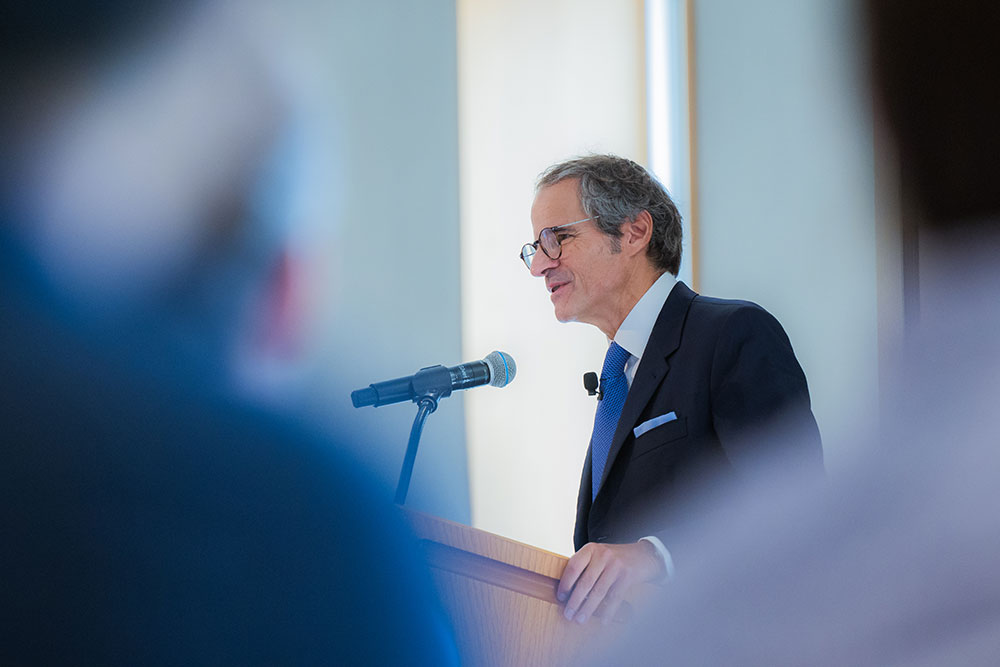Rafael Mariano Grossi speaks about nuclear power’s role at a critical moment in history

On September 22, Rafael Mariano Grossi, director general of the International Atomic Energy Agency (IAEA), delivered the 2023 David J. Rose Lecture in Nuclear Technology at MIT. This lecture series was started nearly 40 years ago in honor of the late Professor David Rose — a nuclear engineering professor and fusion technology pioneer. In addition to his scientific contributions, Rose was invested in the ethical issues associated with new technologies. His widow Dr. Renate Rose, who spoke briefly before Grossi’s lecture, said that her husband adamantly called for the abolishment of nuclear weapons, insisting that all science should serve the common good and that every scientist should follow his or her conscience.
In his prefatory remarks, MIT Vice Provost Richard Lester, a former PhD student of David Rose, said that, even today, many decades after they’d worked together, he still feels the influence of his thesis advisor. Lester called it a “great honor” to introduce Grossi, noting that the director general was guiding the Agency through an especially demanding time. “His presence with us is a reminder that the biggest challenges we face today are truly global challenges, and that international organizations like the IAEA have a central role to play in resolving them.”
The title of Grossi’s talk was “The IAEA at the Crossroads of History,” and he made a strong case for this being a critical juncture, or “inflection point,” for nuclear power. He started his speech, however, with somewhat of an historical footnote, discussing a letter that Rose sent in 1977 to Sigvard Eklund, IAEA’s then-director general. Rose urged the IAEA to establish a coordinated worldwide program in controlled fusion research. It took a while for the idea to gain traction, but international collaboration in fusion formally began in 1985, eight years after Rose’s proposal. “I thought I would begin with this story, because it shows that cooperation between MIT and the IAEA goes back a long way,” Grossi said.
Overall, he painted a mostly encouraging picture for the future of nuclear power, largely based on its potential to generate electricity or thermal energy without adding greenhouse gases to the atmosphere. In the face of rapidly-unfolding climate change, Grossi said, “low-carbon nuclear power is now seen as part of [the] solution by an increasing number of people. It’s getting harder to be an environmentalist in good faith who is against nuclear.”
Public acceptance is growing throughout the world, he added. In Sweden, where people had long protested against radioactive waste transport, a poll now shows that more than 85 percent of the people approve of the nation’s high-level waste handling and disposal facilities. Even Finland’s Green Party has embraced nuclear power, Grossi said. “I don’t think we could imagine a pro-nuclear Green Party five years ago, let alone in 1970 or 80.”
Fifty-seven nuclear reactors are being constructed right now in 17 countries. One of the world’s newest facilities, the Barakah nuclear power plant in the United Arab Emirates, “was built on ground rich in oil and natural gas,” he said. In China, the world’s first pebble-bed high-temperature has been operating for two years, offering potential advantages in safety, efficiency, and modularity. For countries that don’t have any nuclear plants, small modular reactors (SMRs) of this kind “offer the chance of a more gradual and affordable way to scale up nuclear power,” Grossi noted. The IAEA is working with countries like Ghana, Kenya, and Senegal to help them develop the safety and regulatory infrastructures that would be needed to build and responsibly operate modular nuclear reactors like this.
Grossi also discussed a number of lesser-known projects the IAEA is engaged in that have little to do with power generation. Seventy percent of the people in Africa, for example, have no access to radiotherapy to fight cancer. To this end, the IAEA is now helping to provide radiotherapy services in Tanzania and other African countries. At the IAEA’s Marine Environmental Laboratories in Monaco, researchers are using isotopic tracing techniques to study the impact of microplastic pollution on the oceans. The COVID-19 pandemic illustrated the potentially devastating effects of zoonotic diseases that can infect humans with animal-borne viruses. To counteract this threat, the IAEA has sent hundreds of RT-PCR machines — capable of detecting specific genetic materials in pathogens — to more than 130 countries.
Meanwhile, new risks have emerged from the war in Ukraine, where fighting has waged for a year-and-a-half near the six nuclear reactors in Zaporizhzhia—Europe’s largest nuclear power plant. Early in the conflict, the IAEA sent a team of experts to monitor the plant and to do everything possible to prevent a nuclear accident that would bring “even more misery to people who are already suffering so much,” Grossi said. A major accident, he added, would likely stall investments in nuclear power at a time when its future prospects were starting to brighten.
At the end of his talk, Grossi returned to the subject of fusion, which he expects to become an important energy source, perhaps in the not-too-distant future. He was encouraged by the visit he’d just had to the MIT spin-off company, Commonwealth Fusion Systems. With regard to fusion, he said, “for the first time, all the pieces of the puzzle are there: the physics, the policy drivers, and the investment.” In fact, an agreement was signed on the day of his lecture, which made MIT’s Plasma Science and Fusion Center an IAEA collaboration center — the second such center in the U.S.
“When I think of all the new forms of collaboration happening today, I imagine Professor Rose would be delighted,” Grossi said. “It really is something to hold [his] letter and know how much progress has been made since 1977 in fusion. I look forward to our collaboration going forward.”
September 2023. Written by Steve Nadis. Photos by Gretchen Ertl. Videography by MVP.
